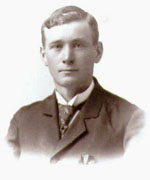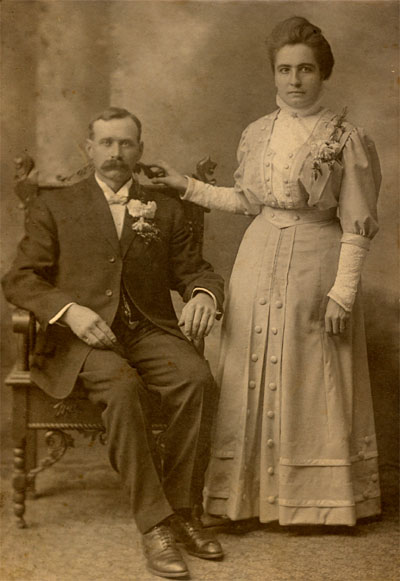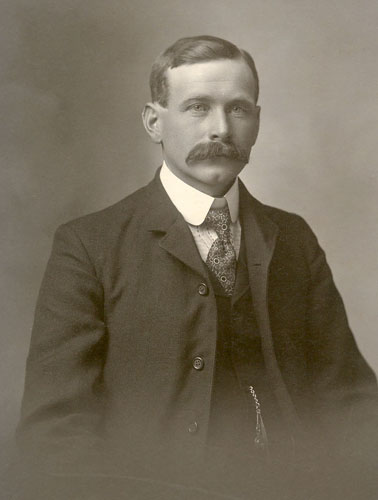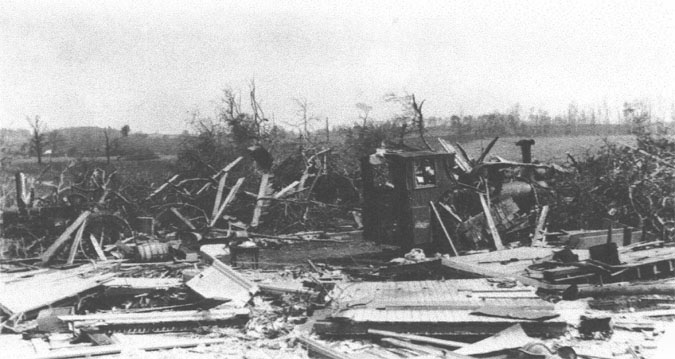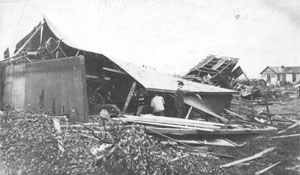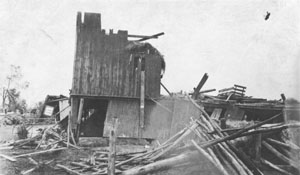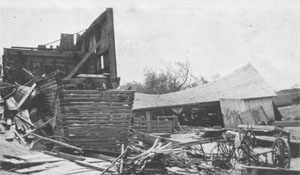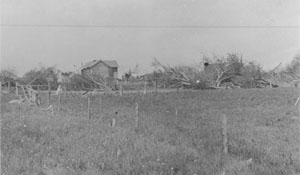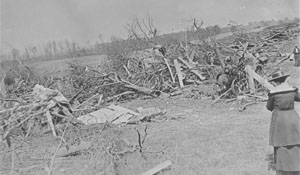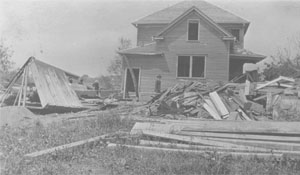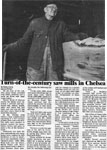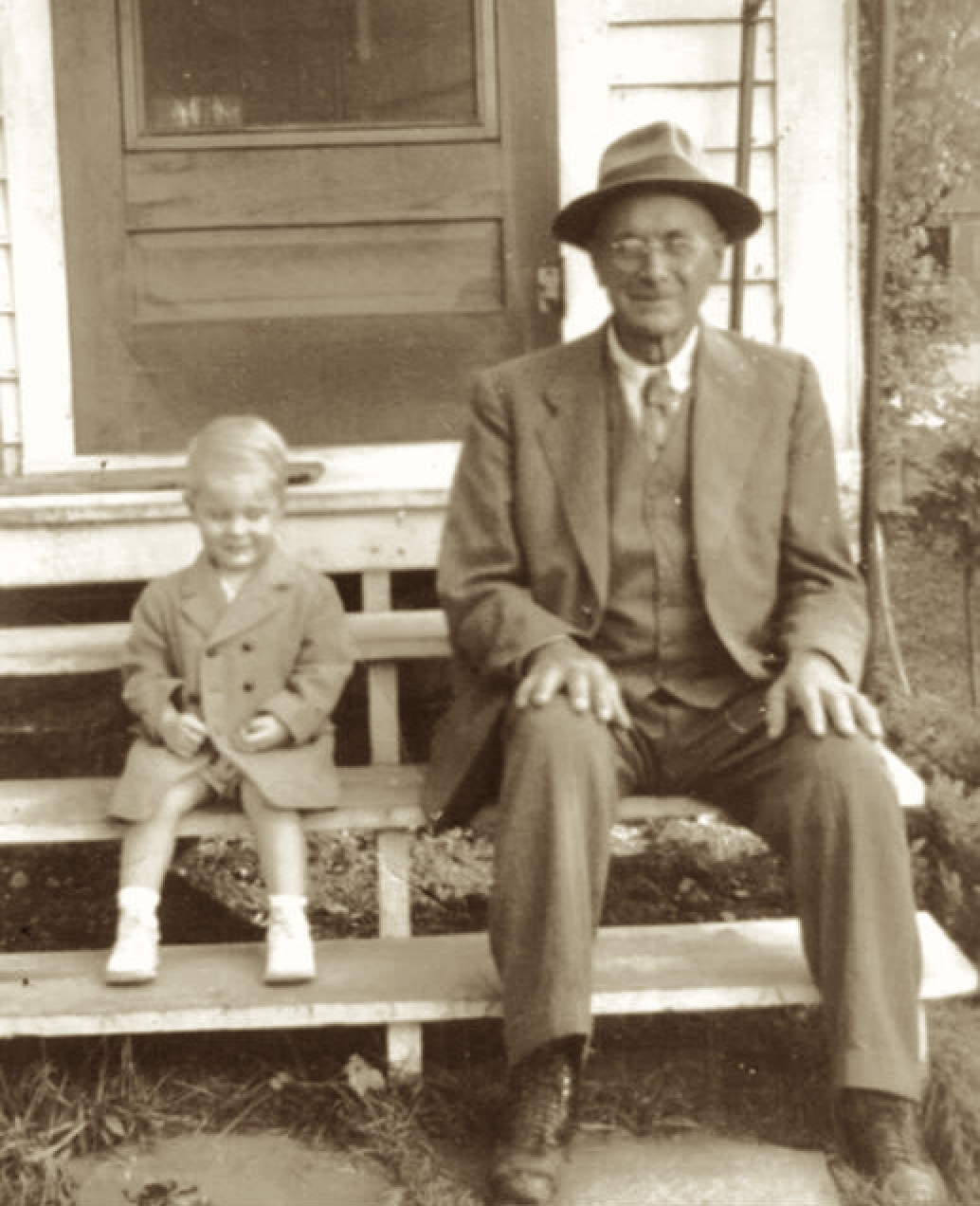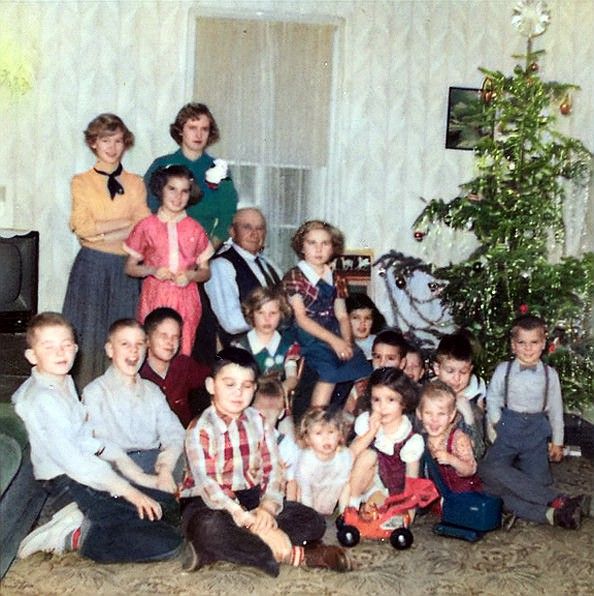 |
"...Various immigrant groups were more or less absorbed into the Ann Arbor community within a few years. Not so the Germans. They learned English but kept their native tongue and made sure their children learned it. They joined local groups and entered politics, but they prayed in their own churches, gathered in their own service organizations, formed their own band, and established their own volunteer fire company, which drew the admiration of their Yankee neighbors. Assimilated and much respected for their industry and public spirit, they nonetheless retained for decades a separate identity as well."
—From "A History of Ann Arbor," by Johnathan Marwil.
Meanwhile, another generation of Wenks were carrying on with the family farming tradition. Germanic-Americans have a history of banding together in close-knit communities and family units. The Wenks were a prime example. They have survived cyclones, a Depression, wars, and draughts so bad that Joseph Wenk once had to feed tree bark to his cows, and have stayed in the same area of Michigan for 150 years, and—until recently—most of them were living on the same ROAD!
|
|
The Michigan Gazetteer of 1837 described the township as: “Lima Center, village and post office, Washtenaw County and Township of Lima, pleasantly situated on the branch of Mill creek has grown up. The territorial road from Ann Arbor to St. Joseph passed through it. This place is quite thriving and there are large quantities of hydraulic power that might be used to advantage in the vicinity.”
Martin stayed close to his family and became a farmer, like his dad, and then bought a threshing business, which he ran with his brothers (and eventually his children).
He also bought a sawmill. In the early 1900's, Martin charged $3-to-$7 for sawing 1000 board feet of trees... and he only lost one finger in all of the decades he ran the mill! (It was reattached by Dr. Bush in Chelsea.) Local farmers brought the logs from their wood lots by horse-drawn sleigh in the springtime, to cut lumber for barns, homes, fences and gates. The steam-powered mill furnished its own fuel by burning lengths of slab-wood (the first cut taken off a log) to heat the water, which was drawn from a nearby stream. The sawdust created by the cutting would be used for mulch, bedding, and ice storage (ice had to be covered in a special shed on all sides by eight inches of sawdust—there were no refrigerators yet).
Family always came first for Martin Wenk, even at his work. The children did all they could in the threshing and sawmill business', and attended school when they could, as well. They were:
 |
CHILDREN OF MARTIN WENK AND MARTHA GRIEB |
|
|
|
|
|
|
|
|
|
|
|
|
|
||||||||||||||||||||||||||||||||||||||||||||||||
Martin and 29-year-old Martha Grieb lived in Lima Township and had one son so far, named Elmer. Martin is listed as a laborer in a threshing business.
Martin used his own family to run the business, training his sons to work in the threshing operation. It was important to him that each child contribute to the enterprise, and that all of his sons work not only to better themselves but the entire family.
Martin's children bonded for life, living mostly on Fletcher Road near the town of Chelsea, around their father's farm. While the other Wenk families continued to attend the same Evangelical church as Ignatz, the Griebs were Lutherans, and Martin switched denominations after the marriage. They worshipped at Zion Lutheran Church, just down the road from the farm. Pressure from anti-German sentiment in the U.S. during the First World War swayed the Americans of German descent in Washtenaw County to largely switch to English as the language spoken both at home and at church. Zion, however, worshipped exclusively in German until 1930, and still has occasional German services for their bilingual congregants, to this day.
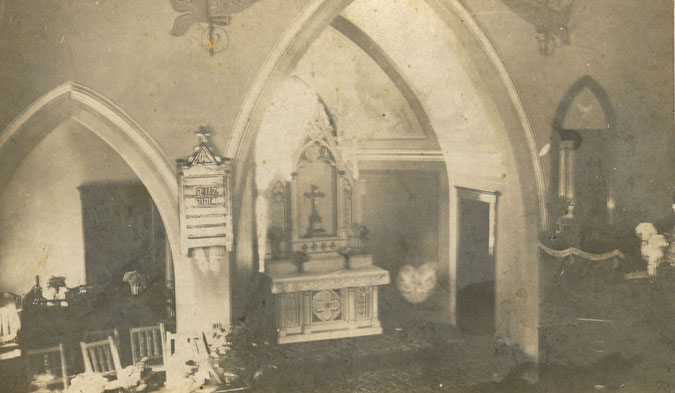 |
The Washtenaw County directory at this time lists Martin as a farmer living in Freedom township, in the village of Chelsea, in Washtenaw County. Chelsea was first settled in 1834, and called "Kedron" until July 19, 1850, when Elisha Congdon renamed it after his old home across the river from Chelsea, Massachusetts. The Village of Chelsea grew rapidly after 1850 as the railroad laid the pathway for business and passenger service. Elisha and his brother James got the Michigan Central Railroad to build a station there in 1848 for land concessions. The town was finally incorporated on October 22, 1864.
When Congress declared war against Germany on 6 Apr 1917, German-Americans started to come under some suspicion in Chelsea, Ann Arbor, Detroit, and other racially diverse areas for having mixed loyalties between their adopted homeland and their place of birth, where they still had family and friends. In Ann Arbor, Eugene Helber's Die Washtenaw Post newspaper (which had posted Ignatz' obituary in German in 1897) came under fire for pro-German editorials, and Helber was even called to a hearing in Washington D.C. for publishing pro-German views. The paper was allowed to continue publication after the hearing, but Helber was compelled to resign from his post, and he was replaced by his son, who then published only in English. After a pro-war bond rally in Ann Arbor on the evening of 15 Apr 1918, several German-owned businesses and offices were smeared with yellow paint, supposedly to identify the disloyal Americans.
|
|
|
Martin's son, Ernest, recalled later to Kathy Clark in a Chelsea newspaper: "The Wenk threshing operation covered parts of four townships, namely Freedom, Sharon, Lima and Sylvain. To operate a steam-powered rig required a fireman engineer, a water boy to keep the engine supplied with water, a blower man, and a machine man. The water supply tank was pulled by two horses. The threshing crew usually slept in the farmer's barn. They had to be on the job early to build a roaring fire to get enough steam pressure to start operations, and set off a steam whistle telling the farmers it was time to get on the job. Each farmer was required to have on hand enough coal to do his work. Farm wives were popular for putting on super good meals.
Martin's daughter-in-law through Erwin, Dorothy Wenk (née Pritchard), remembers: "You had to do a noon meal, most likely roast beef, mashed potatoes, bread, gravy, vegetables—garden or canned. We used home-canned meat but bought roast if we had threshers, and pies for dessert.
"At night we usually served hot dogs, fried potatoes. Probably cake for dessert at night. But the noon meal was the biggest. Ruby and Edna would help me. We would work together a lot. I was glad when threshing was over!
"We would serve least a dozen or more at noon. You had wash basins outside and towels, mirror comb on a bench outside. The water came from tubs or pails as there was no running water inside.
"At our house we did not have enough chairs, so we used crates and boards, covered the boards with blankets for them to sit and eat. You could get more at the table with benches made that way instead of chairs also.
"We kids had to be water boys and bring water to the field workers. We also made lemonade for them to drink. We also served ice tea, coffee and water. Art Grau was my biggest customer for iced tea. Mother always made a crock of lemonade. Hard cider and beer was available for most. My dad made beer and my job was to suck the hose. Maybe that's why I don't like the taste of beer."
|
|
A cyclone tore through Rogers Corners in 1917, destroying several structures, as well as a lot of others on Fletcher and Waters Roads. Joseph Wenk's house on Waters Road was destroyed, as were Martin's and Catherine's Farms. Zion Church and parsonages were damaged. But much of the community came out to help in rebuilding the properties. Fortunately, the Wenks were a hardy, devoted and industrious bunch, and the disaster didn't set them back for very long. Some photographs of the wreckage from the cyclone are displayed below.
THE CYCLONE OF 1917
|
|
|||||||||||||||||||||||||||||||||||||||||||||||
The original 1920 census schedules were destroyed by authorization of the Eighty-third Congress, so it is not possible to consult originals when microfilm copies prove unreadable. But fortunately, we can still read here that Martin and his family are listed right underneath Joseph's. Martin (43) and Martha (39) now have 6 kids: Elmer (10), Erwin (9), Rubena (8), Edna (7), Ernest (5), and Norman (nearly 2). Martin is listed as a "working farmer," as a general laborer and the owner of a threshing business.
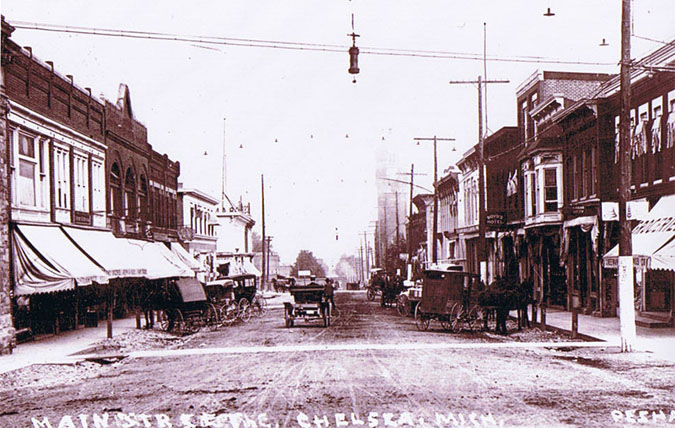 A photograph of Chelsea in the early 20th Century. |
|
|||||||||||||||||||||||||||||||||||||
The 1930 United States Federal Census is the largest census released to date and is the most recent census available for public access. (Census records are not released publicly until exactly 72 years from the official census date.)
This census gives us a glimpse into the lives of Americans in 1930, and contains records for approximately 123 million Americans.
By 1930, Martin (54) and Martha (49—she would die seven years later) are still in Freedom, and all the kids still live at home, working the farm: Elmer (20), Erwin (19), Rubena (18), Edna (16), Ernest (15), and Norman (12). Martin is listed as a "working farmer," as a general farmer, as do all of his sons, but the threshing business is no longer reported.
|
|
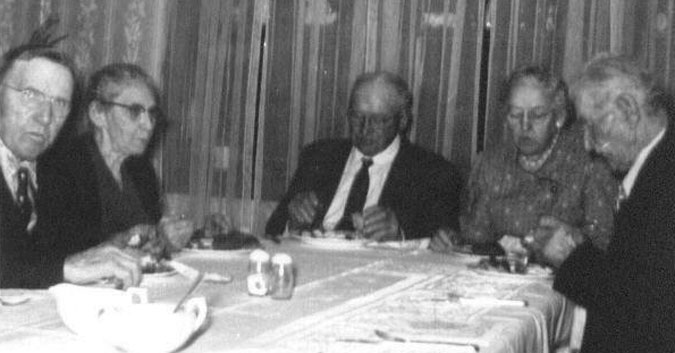 Left to right: Otto Goetz, Louisa Wenk-Goetz, Martin, Lydia Guenther-Wenk and John Wenk. |
|
Meanwhile, Martin's family continued to grow. His beloved wife Martha passed away in 1937, and Martin never remarried. But he watched with pride as the children that he had raised with Martha started their own families, and gave him twenty grandchildren—and those children gave him countless great-grandchildren.
Above is a photo of his 80th birthday party, with siblings John and Louisa, and their spouses. Martin lived until October of 1962, when he passed away at the age of eighty-six. During the course of his life he watched Michigan change from an agricultural paradise to an industrial powerhouse. But the Wenks remained farmers first, and a family always. Martin's beliefs and values continued on through his son, our next ancestor...
 |
PART III: ERWIN WENK (1910-1982)
NOTES ON THIS PAGE:
¹—"From Germany to Washtenaw County: A Story of a German Immigrant and his Descendants in America," by Kurtis McDonald, 1997.
²—"A History of the German settlers in Washtenaw County" by Dale R. Herter and Terry Stollsteimer, 2007.
³—"Stories from the Family of Ignatz Wenk," by Pat Simeck, Martha Hause and Kurtis McDonald, 2006.
⁴—"Driving Tour of 19th and 20th Century Settlement and Farms Washtenaw County, Michigan," Washtenaw.org.
TOP PHOTO: Martin Wenk and brother-in-law Eugene Grieb posing in front of some heavy Machinery: Martin's steam tractor and thresher.
|
CHAPTER 1: WENKS FROM FROM BADEN TO WORSE, 1705 - 1849 CHAPTER 2: IGNATZ WENK, 1850 - 1997 CHAPTER 3: MARTIN WENK, 1876 - 1962 CHAPTER 4: ERWIN WENK, 1910 - 1982 CHAPTER 5: THE WENK FAMILY TODAY, 1940 - PRESENT
APPENDIX A: WENK FAMILY REUNIONS, 1923-PRESENT APPENDIX B: CENSUS REPORTS, 1870 - 1950 APPENDIX C: FAMILY TIMELINE, 1700-PRESENT
|
